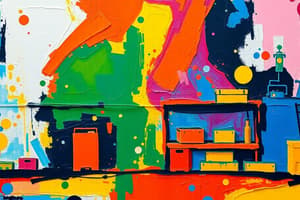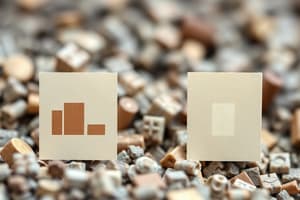Podcast
Questions and Answers
What is the primary purpose of economic models?
What is the primary purpose of economic models?
- To represent economic data in a complex format
- To simplify reality for understanding complex economic relationships (correct)
- To show historical data trends
- To explain individual behaviors in the market
Which of the following is NOT an economic indicator?
Which of the following is NOT an economic indicator?
- Economic model complexity (correct)
- Gross Domestic Product (GDP)
- Inflation rate
- Unemployment rate
What role do interest rates play in an economy?
What role do interest rates play in an economy?
- They reflect the rate of unemployment
- They determine the total value of goods produced
- They measure the level of inflation
- They indicate the cost of borrowing money (correct)
What does the concept of comparative advantage explain in international economics?
What does the concept of comparative advantage explain in international economics?
Which economic indicator represents the percentage of the labor force that is unemployed?
Which economic indicator represents the percentage of the labor force that is unemployed?
What is the focus of microeconomics?
What is the focus of microeconomics?
Which concept is NOT a key part of economics?
Which concept is NOT a key part of economics?
What do Keynesian economists believe is necessary to stabilize the economy?
What do Keynesian economists believe is necessary to stabilize the economy?
Which economic system prioritizes social ownership and equity?
Which economic system prioritizes social ownership and equity?
What is a primary focus of macroeconomics?
What is a primary focus of macroeconomics?
Which of the following best describes classical economics?
Which of the following best describes classical economics?
How do elasticities influence microeconomic analysis?
How do elasticities influence microeconomic analysis?
Which school of thought focuses on the money supply's role in inflation?
Which school of thought focuses on the money supply's role in inflation?
Flashcards
Economic Model
Economic Model
A simplified representation of reality used to understand complex economic relationships.
Gross Domestic Product (GDP)
Gross Domestic Product (GDP)
The total value of goods and services produced in an economy within a specific time period.
Unemployment Rate
Unemployment Rate
The percentage of the labor force that is actively seeking employment but unable to find a job.
Inflation Rate
Inflation Rate
Signup and view all the flashcards
Interest Rate
Interest Rate
Signup and view all the flashcards
Microeconomics
Microeconomics
Signup and view all the flashcards
Macroeconomics
Macroeconomics
Signup and view all the flashcards
Scarcity
Scarcity
Signup and view all the flashcards
Opportunity Cost
Opportunity Cost
Signup and view all the flashcards
Supply and Demand
Supply and Demand
Signup and view all the flashcards
Market Equilibrium
Market Equilibrium
Signup and view all the flashcards
Capitalism
Capitalism
Signup and view all the flashcards
Socialism
Socialism
Signup and view all the flashcards
Study Notes
Introduction to Economics
- Economics is the social science that studies how societies allocate scarce resources to satisfy unlimited wants and needs.
- It focuses on the production, distribution, and consumption of goods and services.
- Key concepts include scarcity, opportunity cost, supply and demand, and market efficiency.
- Economics can be broadly divided into microeconomics and macroeconomics.
- Microeconomics analyzes the behavior of individual economic agents, such as households and firms.
- Macroeconomics examines the overall performance of the economy, such as inflation, unemployment, and economic growth.
Microeconomics
- Studies individual markets and agents.
- Focuses on supply and demand analysis to explain prices, quantities, and market equilibrium.
- Key concepts include elasticity, market structures (e.g., perfect competition, monopoly), and production costs.
- Explores consumer behavior and decision-making processes.
- Models consumer preferences with utility functions.
- Examines producer behavior, including profit maximization and cost minimization.
- Studies the impact of government intervention, such as taxes and regulations, on markets.
Macroeconomics
- Studies the overall economy.
- Focuses on aggregate variables like GDP, inflation, unemployment, and interest rates.
- Explores economic growth, business cycles, and economic fluctuations.
- Analyses factors that affect aggregate demand and supply.
- Examines different fiscal and monetary policies to stabilize the economy.
- Considers the role of government in influencing the economy.
Key Schools of Thought
- Different schools of thought offer different perspectives on economic issues and policy.
- Key schools include classical economics, Keynesian economics, and monetarism.
- Classical economics emphasizes free markets and limited government intervention.
- Keynesian economics highlights the role of government intervention to stabilize the economy.
- Monetarism emphasizes the role of money supply in inflation and economic fluctuations.
Major Economic Systems
- Capitalism: Emphasizes private ownership of resources, free markets, and profit motive.
- Socialism: Prioritizes social ownership and control of resources and emphasizes equity.
- Communism: Advocates for a classless society with shared ownership of all resources.
- Mixed economies: Combine elements of different systems, with varying degrees of government involvement.
Economic Models
- Economic models simplify reality to understand complex economic relationships.
- Models use assumptions and simplifications to focus on key variables and their interactions.
- Different models are used to explain various economic phenomena.
- Models allow for predictions and analysis of potential outcomes in different situations.
- Graphical models are essential for understanding complex relationships in economics.
Economic Indicators
- Gross Domestic Product (GDP): Measures the total value of goods and services produced in an economy.
- Unemployment rate: Represents the percentage of the labor force that is unemployed.
- Inflation rate: Measures the rate at which prices of goods and services are rising.
- Interest rates: Reflects the cost of borrowing money.
- These indicators are used to assess the overall health of an economy and guide policy decisions.
International Economics
- Studies the interactions between countries in the global economy.
- Focuses on trade, investment, and exchange rates.
- Explores comparative advantage and its impact on international trade patterns.
- Analyses international financial institutions and their role in global economic cooperation.
Studying That Suits You
Use AI to generate personalized quizzes and flashcards to suit your learning preferences.




